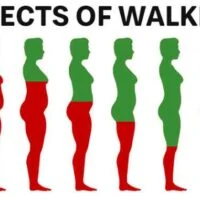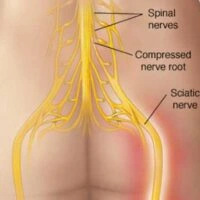Walking is more than just a means of transportation or a simple physical activity; it is an accessible pathway to improved mental and emotional well-being. With each step taken, the body and mind embark on a journey towards harmony.
Scientific studies have linked regular walking to significant enhancements in mood and reductions in stress levels. This suggests its power extends beyond physical fitness to encompass mental wellness.

Through the rhythmic and aerobic nature of walking, individuals can tap into a host of mental health benefits. This gentle, low-impact exercise increases the production of endorphins, the body’s own feel-good neurotransmitters, which act as natural stress relievers.
Additionally, walking provides an opportunity to break away from the monotony of daily life, offering a chance to clear one’s mind, engage with the surrounding environment, and cultivate mindfulness.
Key Takeaways
- Walking contributes to the production of endorphins which elevate mood and reduce stress.
- It serves as a meditative practice that can clear the mind and foster mindfulness.
- Regular walking habits can lead to long-term improvements in emotional and mental health.
The Science of Walking and Mental Well-Being
Recent studies illuminate the significant role walking plays in enhancing mental well-being. By exploring various psychological dimensions, such findings give credence to walking as an effective, accessible intervention for mental health maintenance.
Understanding the Psychological Effects of Walking
Researchers recognize walking as a beneficial, easy-to-integrate activity for psychological health. For instance, an increase in mental clarity and emotional balance is reported when individuals engage in regular walking regimes.
Notable improvements in cognitive function demonstrate the multifaceted psychological benefits walking provides.
Benefits of Walking on Stress and Anxiety
Walking contributes to stress and anxiety reduction, as evidenced by physiological changes like lower heart rate and muscle relaxation.
An examination of walking interventions highlighted their effectiveness in alleviating symptoms of anxiety. These interventions can be simple yet impactful steps toward managing daily stressors.
Walking’s Impact on Mood and Self-Esteem
The act of walking, particularly in natural settings, positively influences mood and self-esteem. It enhances an individual’s sense of self-worth and mood state.
A systematic review focusing on nature walks linked them with considerable uplifts in mood and self-esteem, reinforcing walking’s role in emotional well-being.
How Walking Helps Fight Depression
In the fight against depression, walking has emerged as a key non-pharmacological strategy. A meta-analysis indicates that walking, especially when practiced consistently, can lead to a decrease in depressive symptoms.
The simplicity of walking makes it an inclusive method for combating depression, potentially reducing reliance on medication for some individuals.
Physical Health Benefits Related to Mental Health
Physical activity, such as walking, offers numerous health benefits that directly impact mental well-being. By improving blood circulation and managing blood pressure, walking can play a crucial role in mitigating the effects of chronic physical conditions, which in turn, contributes to mental health.
Exercise and Blood Circulation
Regular physical activity, like walking, enhances blood circulation, which is vital for delivering oxygen and nutrients to tissues and organs.
This improved circulation can boost brain function, thereby elevating mood and reducing the risk of cognitive decline.
The Role of Walking in Managing Blood Pressure
Walking is a proven method to lower blood pressure.
Maintaining a routine walking schedule can lead to long-term cardiovascular health, which is intrinsically linked to a reduced risk of developing mental health issues commonly associated with hypertension.
Walking’s Effect on Chronic Physical Conditions
Engaging in consistent walking can mitigate the impact of chronic conditions such as diabetes, heart disease, and cancer.
By helping control blood sugar levels and maintaining healthy cholesterol, walking can lessen the mental stress associated with managing these conditions and prevent feelings of anxiety and depression related to them.
Engaging with Nature and Environment
Walking not only promotes physical well-being but also enhances mental and emotional health. Engaging with the environment, particularly in nature, elevates the experience, providing psychological advantages and differing impacts based on the setting.
The Psychological Advantages of Outdoor Walking
Outdoor walking, particularly in natural settings, has been associated with boosting mental health.
Research suggests that sessions ranging from 20 to 90 minutes in natural environments yield the most significant benefits.
Activities such as gardening, nature-based therapy, and exercising in green spaces have been particularly effective for adults.
One does not need an extensive walking routine; even short durations have proven beneficial for mental health.
These findings reinforce the importance of integrating walking into one’s routine, tailoring the walking route to include as much exposure to natural environments as possible.
Urban vs. Natural Walking Settings
Contrasting with natural environments, urban settings offer a different experience.
While walking anywhere provides physical benefits, studies indicate that walking in natural environments has added mental health benefits over walking in urban spaces or indoors.
Group walks in nature, for instance, significantly improve mental health, compared to group walks in urban environments.
This highlights the need for city planners to incorporate green spaces into urban designs, ensuring residents can reap the psychological benefits of walking amidst nature without traveling far from their daily urban routes.
Developing a Sustainable Walking Habit

Incorporating walking as a staple in one’s daily routine can lead to substantial emotional and mental benefits. Crafting a disciplined yet flexible walking habit requires a deliberate approach to embed the activity into one’s lifestyle.
Creating a Walk-Friendly Daily Routine
To establish a daily walk as a non-negotiable aspect of the day, one should integrate it into their current schedule seamlessly.
Identifying a consistent time slot, whether it’s a morning stroll to awaken the muscles or an evening brisk walk to decompress, helps in solidifying this habit.
Incorporating walking into existing routines, such as walking to run errands or taking a short stroll after lunch, can make the habit stick without it feeling like an additional task.
- Morning Walk: Kickstart metabolism and invigorate muscles.
- Lunchtime Stroll: Break up the day and boost mental clarity.
- Evening Walk: Unwind and reflect on the day’s events.
Tracking Progress and Setting Goals
Using a pedometer or a similar device can be motivating for individuals as they track the number of steps taken each day.
An initial goal might be to reach a certain step count, like the often-recommended 10,000 steps, before progressively increasing the target as endurance builds.
Besides counting steps, measuring distance or time spent on daily walks can provide tangible milestones to achieve.
Setting both short and long-term goals ensures there is always a future achievement to strive towards, keeping motivation high.
- Step Goals: Start with a manageable number of steps and increase gradually.
- Distance Objectives: Aim to extend the daily walk distance each week.
- Timed Targets: Incorporate timed brisk walking intervals to elevate heart rate.
Optimizing the Walking Experience
To truly harness the mental and emotional benefits of walking, one can enhance the experience by incorporating mindful practices and leveraging technology. These methods have shown to amplify the positive outcomes of a regular walking routine.
Incorporating Mindfulness and Meditation
Mindfulness during walking turns a simple activity into a meditative practice.
This involves being fully present and aware of one’s surroundings, the sensations of the body, and the rhythm of breathing.
A mindful walk encourages individuals to observe without judgment, which has been linked to reduced stress levels and better mood regulation, as suggested at MedShadow.
Techniques can include focusing on the sensation of feet touching the ground, the pattern of breath, or even the sounds and sights along the path.
Enhancing the Walk with Technology
Using technology can make a walk more enjoyable as well as beneficial.
Many individuals find that listening to a podcast or curated music playlist can turn their walk into an informative, educational, or more enjoyable experience.
There are applications specifically designed to track walking routes, set fitness goals, and even overlay meditation guides to walks.
These apps promote an engaging atmosphere that can motivate and improve mental well-being during the walk.
Social and Communal Aspects of Walking

Walking serves as more than just physical exercise; it’s a vibrant social conduit that facilitates interactions and builds community networks.
The Role of Walking in Social Interaction
Walking is intricately linked with social interaction. As individuals partake in neighborhood strolls or organized walking groups, they often engage in conversations leading to new friendships and stronger community bonds.
In fact, evidence from a PMC article suggests that neighborhood walking can significantly strengthen social ties, granting access to vital emotional support and facilitating social connectedness.
Moreover, group walks inherently include a blend of social motivations alongside physical benefits. They are occasions for shared experiences, exchange of ideas, and mutual encouragement.
Harvard Health Publishing reports that walking with friends not only aids in maintaining an exercise routine but also provides mental stimulation and helps to ward off feelings of loneliness and isolation.
This union of physical activity with social interaction enriches the walking experience and contributes to the emotional well-being of the participants.
The regularity of walking with others adds a predictable social component to daily life, fostering long-term relationships and creating a sense of belonging within a community. It’s through these reliable social patterns that walking transforms from a solitary activity into one rich with communal benefits.
Physical Preparations and Considerations

Before embarking on a walking regimen, it’s important to prepare the body to minimize injuries and maximize the benefits of exercise. This involves a proper warm-up, choosing a walking program of appropriate intensity, and understanding the significance of recovery.
Warming Up and Stretching
Prior to walking, one should warm up to gradually increase heart rate and blood flow to the muscles. A simple 5-minute brisk walk can serve as an effective warm-up.
Adding dynamic stretches, such as leg swings or walking lunges, can improve flexibility and prepare the muscles and joints for activity.
Choosing the Right Duration and Intensity
Individuals need to tailor their walking duration and intensity to their current fitness levels.
Beginners might start with 15-minute walks at a light intensity, gradually increasing to 30 minutes or more as stamina builds.
Consulting a therapist or physician can provide guidance on a suitable program, especially for those with health considerations.
Recovery and Listening to Your Body
After walking, a cool-down period with stretching helps transition the body to a resting state and can reduce muscle stiffness.
It is critical for individuals to listen to their bodies and allow for adequate recovery, especially if they experience pain or discomfort.
Rest days are essential for the body to repair and strengthen, and they can be as important as the walks themselves.
Long-Term Health and Lifestyle Changes
Regular walking offers a simple yet profound way to enhance one’s overall health, providing benefits that extend to cardiovascular health, improved sleep, weight management, and laying the groundwork for a healthy lifestyle.
Walking for Cardiovascular Health
Walking consistently can lead to significant improvements in cardiovascular health.
Engaging in brisk walks for at least 30 minutes a day can increase heart rate, ensuring the heart muscle gets a good workout.
As a result, these walks help maintain the elasticity of blood vessels, effectively circulate oxygen and nutrients via the bloodstream, and can even help lower blood pressure over time.
- Benefits for the heart include
- Improved circulation
- Reduced risk of heart disease
- Enhanced oxygen delivery to cells
Improving Sleep and Managing Weight
A regular walking routine contributes to better sleep patterns.
Evening walks, in particular, can help people wind down and prepare for sleep by reducing stress and tension.
Moreover, walking can be fundamental in weight management by expending calories and regulating body systems.
The natural movement of walking also forces the bones to bear weight, which can help to strengthen bones and maintain their density—a crucial factor for long-term skeletal health.
- Sleep improvements:
- Decrease in insomnia
- Regulation of sleep cycles
- Weight management:
- Caloric burn that aids in maintaining or losing weight
- Appetite regulation
Building a Foundation for a Healthy Lifestyle
Adopting walking as a part of one’s daily routine paves the way for a more active and healthy lifestyle.
It’s accessible and sustainable, making it an ideal starting point for individuals new to regular exercise.
By integrating walking into their lives, individuals develop a positive habit that reinforces other healthy behaviors, such as choosing more nutritious foods and staying hydrated.
Embracing walking is acknowledging the value of consistent, moderate activity and its role in nurturing long-term wellbeing.
- Healthy lifestyle habits encouraged by walking:
- Consistent activity integrated easily into daily life
- Healthier choices in other areas, embraced naturally over time
Creative and Emotional Advantages of Walking
Walking is not just a physical activity; it also offers significant benefits for emotional health and creative thinking.
Walking to Decompress and Enhance Creativity
Decompression: Engaging in regular walking can help individuals decompress. It allows the mind to break free from the confines of stress and anxiety.
The rhythmic nature of walking is known to promote a calm and meditative state, enabling emotional decompression and fostering a clearer headspace.
Creativity: The act of walking has also been tied to enhanced creativity.
When individuals walk, they stimulate brain activity, which may lead to increased cognitive function and the generation of new ideas.
In fact, studies suggest that walking, especially in natural environments, can result in a surge of creative problem-solving skills by as much as 60%.
Emotional Health: Walking’s contribution to emotional health is notable.
It provides an opportunity for emotional release and increases in positive affect, thus improving overall mood and wellbeing.
This can be especially true in settings free from serious air pollution, where the benefits of walking exercise for emotional health can be more pronounced.
Walking as a Complementary Therapy
Walking, often recommended by health professionals, has surfaced as a beneficial complementary therapy in various recovery programs. It not only aids in physical recuperation but also promotes mental and emotional well-being, enhancing the overall therapy experience.
Integrating Walking into Recovery Programs
Recovery programs, whether they are in a hospital setting or a rehabilitation center, have started to incorporate walking as a key component of their regimen.
The physical benefits of walking—such as improved circulation, strengthened muscles, and better cardiovascular health—make it an excellent activity for individuals on the mend.
For example, Nordic walking, with its use of poles to engage upper body muscles, can be particularly beneficial in physical therapy.
It’s a low-impact exercise that also supports balance and mobility. Programs that have included this form of walking report notable results in the recovery progress of their patients.
Consulting with Health Professionals
Patients are advised to consult with health professionals before starting any complementary walking therapy.
Therapists can tailor walking programs to suit individual needs, taking into account the patient’s current health status and the chance of injury.
The guidance ensures that walking serves as a safe and effective complement to conventional therapeutic practices.
Incorporating walking into a therapeutic program under professional supervision can greatly contribute to the successful recovery of patients.
As therapists monitor progress, they can adjust the intensity and duration of the walking sessions to align with the patient’s evolving needs, optimizing the benefits of this holistic practice.
Frequently Asked Questions

Walking is a simple activity that can provide significant improvements in mental and emotional health. Exploring its benefits can shed light on why incorporating a walk into one’s daily routine is advantageous.
How can walking daily improve mental well-being?
Walking daily fosters a sense of well-being by promoting the release of endorphins, which are the body’s natural mood elevators.
This activity is linked to better endurance and elevated energy levels, contributing to overall mental wellness.
What impact does walking have on anxiety and depression levels?
Regular walking has been shown to alleviate symptoms of anxiety and depression.
This form of physical exercise assists in reducing the body’s stress hormones, such as adrenaline and cortisol, and can create a sense of clarity, helping individuals cope with these conditions.
In what ways does walking contribute to emotional health?
Walking increases exposure to natural light, which can help regulate circadian rhythms and lead to improved sleep.
It’s an effective means to disconnect from daily stressors, providing an opportunity for psychological restoration.
What about shoes?
It’s crucial to discuss the importance of appropriate footwear, particularly women’s running shoes. These shoes are not just for running; they are designed to provide the necessary support and cushioning for all types of physical activities, including walking. A good pair of running shoes can make a significant difference in comfort and injury prevention. For women over 40, who may experience joint sensitivity or arthritis, the right running shoes can offer the stability and shock absorption needed to protect the knees, ankles, and hips during walking. When choosing running shoes, look for features like adequate arch support, a comfortable fit, and durable, non-slip soles. Investing in high-quality running shoes is an investment in your health and well-being, ensuring that you can continue to walk and maintain your weight effectively, with reduced risk of discomfort and injury.
Can regular walking help alleviate stress?
Yes, engaging in regular walking can be a powerful stress reliever.
The rhythmic nature of walking is considered a natural tranquilizer, aiding to reduce mental fatigue and stress relief.
How does walking for 30 minutes daily benefit your mental state?
Even short daily walks of 30 minutes can result in significant mental health benefits, such as improved blood pressure and better control of blood sugar, both of which play roles in reducing anxiety and improving mood stability.
What are the psychological effects of engaging in regular walking?
The psychological effects of engaging in regular walking include enhanced self-esteem, better cognitive function, and a feeling of accomplishment.
Furthermore, regular walking can help ease symptoms of various common co-occurring conditions. This includes IBS, due to systemic benefits of exercise.



